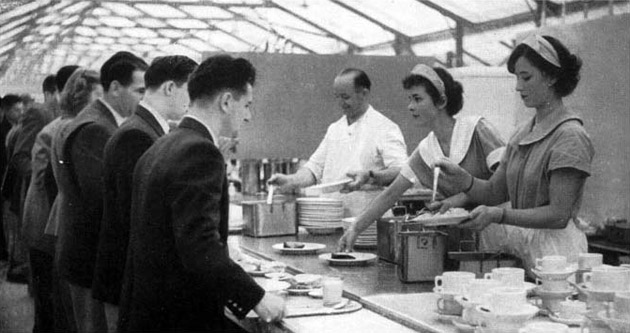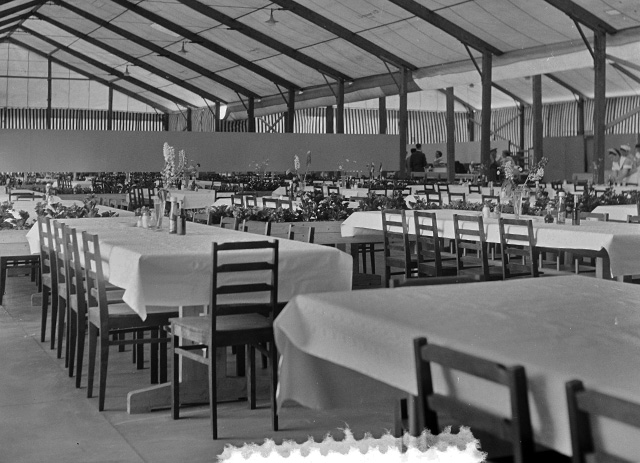The food supplied for the athletes at an Olympic Village needs to cater to a diversity of sports, cultures, ages and special dietary needs. Here is some information about the Olympic Village food hall and menu for Helsinki in 1952. See more about Olympic Village nutrition and links to information about the food supplied at other Olympic Games.
 Food service at the Olympic Village food hall
Food service at the Olympic Village food hallfrom the Olympic Games Official Report Helsinki 1952
1952 Helsinki Food Halls
Most of the competitors were housed at the Käpylä Olympic Village. To cater to the food service to the 4,800 participants housed there, a large temporary tent structure with wooden floors had to be constructed. The total covered area was approx. 5,500 sq. metres.
The restaurant section was divided into six dining rooms, each with its own kitchen. The storage department had a central refrigerating room, grocery and crockery stocks, storerooms for vegetables and roots, peeling and cleaning rooms, a dining room and dressing rooms and lavatories for the staff, and the restaurant's office. Connecting with the first kitchen was an open-air restaurant.
Although three meal service times were created, in actual practice the self-service restaurant was in continuous use from 7am untill 11pm.
A selection of cuisines
A comprehenisve food service was required to cater to the competitors of 69 nationalities. In the Käpylä Olympic Village, kitchens were set up for the following cuisines:
- Latin-American
- British-American
- Scandinavian
- Central European
- Oriental
Supplementing these kitchens were a common pre-cookery kitchen, two kitchens for cold foods, a staff kitchen and a cafeteria restaurant.
Weekly basic menus were printed for all five cuisines. Breakfast was the same every day. The daily menus were supplemented in accordance with team wishes for their particular cuisine.
Some countries requested kitchens of their own, which was supplied at a cost. France and Belgium set up a joint kitchen at their housing site, Italy and Israel each had their own. At the Otaniemi athlete village, a kitchen capable of serving 350 people was built for the U.S.S.R. team. They supplied their own crockery and even brought part of the cooking equipment with them. This team also procured its own raw materials and kitchen staff. Poland, Czechoslovakia, Rumania and Bulgaria were served by a joint kitchen supplying two different menus. Hungary had their own kitchen. The Chinese team ate with the Russians.
In the Women's Village the following four kitchens were set up, with women competitors from Italy and Israel joining their male teammates' kitchens.
- British-American
- Latin-American
- Central European
- Oriental
 Athlete food tent for Helsinki 1952
Athlete food tent for Helsinki 1952 What did they eat?
The total consumption of food raw materials at the Käpylä kitchen centre was 373,905 kilos. The biggest items were vegetables 82,300 kilos, meat 60,599 kilos, milk 55,500 litres, soft drinks and fruit juices 53,600 litres, fruit 33,565 kilos and bread 28,360 kilos.
The official report of the Olympics listed the following interesting facts:
- Consumption per head was high, 4,000 to 5,000 calories per day.
- Diets differed during training and competing periods.
- Special care had to be paid to the quality and cooking of meat. In greatest demand were beef, mutton and chicken.
- Foods fried in fat were avoided.
- Little fish was eaten.
- The most popular dessert was ice cream.
- Wheat and graham bread were very popular.
- The consumption of milk, butter, raw vegetables and fruit was heavy.
- Honey, maltose and grape sugar played an important part in athletes' diets.
- Canned raw foods were avoided.
- Favoured beverages, along with milk, were ice water, fruit juices and mild pilsner.
Source: THE OFFICIAL REPORT OF THE ORGANISING COMMITTEE FOR THE GAMES OF THE XV OLYMPIAD HELSINKI 1952
Related Pages
- Olympic Village nutrition, includes links to information about the menu at other Olympic Games.
- Nutrition at the Olympics
- History of the Olympic Games Athlete Villages
- About the Olympic Games
- Sport in Finland
- Nutrition for Athletes at Major Events


 Current Events
Current Events